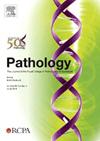High proportion of clinically significant prostate adenocarcinomas in radical cystoprostatectomy specimens following complete prostate sampling
IF 3
3区 医学
Q1 PATHOLOGY
引用次数: 0
Abstract
Clinically silent prostate adenocarcinoma may be detected as an incidental finding in radical cystoprostatectomy specimens. In previous studies, there have been major inconsistencies, both in the incidence of occult prostate adenocarcinoma, ranging from 2% to 60% of cases in reported series, and their significance in a clinical context. Much of the conflicting data in earlier studies relate to methodological issues such as small sample size, incomplete sampling of the prostate and lack of central review of pathological material. In this study, we have reviewed a series of 261 patients who underwent cystoprostatectomy for urothelial carcinoma, between the inclusive years 2010 and 2022, in order to determine the incidence and clinical significance of any prostate carcinomas discovered as part of the histological examination. All prostate glands in the series were fully embedded with sections taken from each block, and all cases were independently reviewed. The series contained 140 occult carcinomas, with the distribution according to patient age being 40–49 years (3 cases), 50–59 years (11 cases), 60–69 years (48 cases), 70–79 years (67 cases) and 80–89 years (11 cases). Within the age cohorts of 50–59 years, 60–69 years and 70–79 years, 34.1%, 53.9% and 57.7% of prostates, respectively, had prostate adenocarcinoma. Division of tumours according to Gleason score showed 3+3=6 (31.4%), 3+4=7 (47.9%), 4+3=7 (10%), 3+4=7 tertiary 5 (3.6%), 4+5=9 (5%) and 5+4=9 (2.1%). Clinically significant features were a Gleason score >6 in 68.8% of cases and a tumour volume >0.5 cm3 in 37.1% of cases. Both features were present in 37.1% of cases. Extension beyond the prostate was seen in nine cases. Our series shows that prostate adenocarcinoma is a common incidental finding in patients undergoing radical cystoprostatectomy, with many tumours having features associated with more aggressive disease. These results suggest that clinical assessment for prostate cancer and pre-operative multiparametric magnetic resonance imaging of the prostate should be undertaken, especially for patients in whom a more conservative surgical approach is planned.
完全前列腺取样后根治性膀胱前列腺切除术标本中高比例的临床显著性前列腺腺癌。
临床无症状的前列腺癌可能在根治性膀胱前列腺切除术标本中偶然发现。在以往的研究中,无论是在隐蔽性前列腺癌的发病率(在报道的系列病例中占2%至60%),还是在临床背景下的意义上,都存在重大的不一致。早期研究中许多相互矛盾的数据与方法学问题有关,如样本量小、前列腺样本不完整以及缺乏病理材料的中心综述。在本研究中,我们回顾了2010年至2022年间261例因尿路上皮癌接受膀胱前列腺切除术的患者,以确定组织学检查中发现的任何前列腺癌的发病率和临床意义。该系列的所有前列腺都被从每个块上取下切片,并被完全嵌入,所有病例都被独立审查。本研究共发现隐蔽性癌140例,按患者年龄分布为40-49岁3例、50-59岁11例、60-69岁48例、70-79岁67例、80-89岁11例。在50-59岁、60-69岁和70-79岁年龄组中,前列腺癌发生率分别为34.1%、53.9%和57.7%。肿瘤按Gleason评分分为3+3=6(31.4%)、3+4=7(47.9%)、4+3=7(10%)、3+4=7(3.6%)、4+5=9(5%)、5+4=9(2.1%)。临床显著特征为68.8%的病例Gleason评分为bb0.6, 37.1%的病例肿瘤体积为>0.5 cm3。37.1%的病例同时存在这两种特征。前列腺外延伸9例。我们的研究表明,前列腺癌是根治性膀胱前列腺切除术患者常见的偶然发现,许多肿瘤具有与更具侵袭性疾病相关的特征。这些结果表明,对于前列腺癌的临床评估和术前前列腺多参数磁共振成像应该进行,特别是对于那些计划更保守的手术入路的患者。
本文章由计算机程序翻译,如有差异,请以英文原文为准。
求助全文
约1分钟内获得全文
求助全文
来源期刊

Pathology
医学-病理学
CiteScore
6.50
自引率
2.20%
发文量
459
审稿时长
54 days
期刊介绍:
Published by Elsevier from 2016
Pathology is the official journal of the Royal College of Pathologists of Australasia (RCPA). It is committed to publishing peer-reviewed, original articles related to the science of pathology in its broadest sense, including anatomical pathology, chemical pathology and biochemistry, cytopathology, experimental pathology, forensic pathology and morbid anatomy, genetics, haematology, immunology and immunopathology, microbiology and molecular pathology.
 求助内容:
求助内容: 应助结果提醒方式:
应助结果提醒方式:


